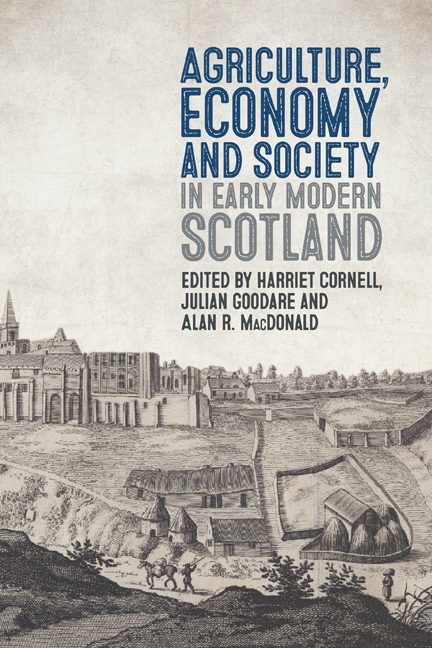Book contents
- Frontmatter
- Dedication
- Contents
- Illustrations
- Contributors
- Acknowledgements
- Note on Currency and Measures
- Abbreviations
- Map of Scotland
- Introduction: Exploring Scotland’s Agricultural History
- 1 Imagining Scottish Agriculture before the Improvers
- 2 The Use of Dykes in Scottish Farming 1500–1700
- 3 The Famine of 1622–23 in Scotland
- 4 Weather and Farming through the Eyes of a Sixteenth-Century Highland Peasant
- 5 Stock, Fermes, Mails and Duties in a Midlothian Barony 1587–89
- 6 The Roots of Improvement: Early Seventeenth-Century Agriculture on the Mains of Dundas, Linlithgowshire
- 7 ‘God Knowis my Sleipis ar Short and Unsound’: Andro Smyth’s Collection of Rent, Tax, Teind and Tolls in Shetland c.1640
- 8 Farming in the Stirling Area 1560–1750
- 9 What Were the Fiars Prices Used For?
- 10 Agriculture and Banking in Eighteenth-Century Scotland 1695–1750
- 11 Capitalism’s Cradle? Ideas, Policies and the Rise of the Scottish Economy in the Mercantilist Age 1600–1800
- Conclusion: A Historiographical and Bibliographical Overview
- Index
- Boydell Studies in Rural History
Conclusion: A Historiographical and Bibliographical Overview
Published online by Cambridge University Press: 14 May 2024
- Frontmatter
- Dedication
- Contents
- Illustrations
- Contributors
- Acknowledgements
- Note on Currency and Measures
- Abbreviations
- Map of Scotland
- Introduction: Exploring Scotland’s Agricultural History
- 1 Imagining Scottish Agriculture before the Improvers
- 2 The Use of Dykes in Scottish Farming 1500–1700
- 3 The Famine of 1622–23 in Scotland
- 4 Weather and Farming through the Eyes of a Sixteenth-Century Highland Peasant
- 5 Stock, Fermes, Mails and Duties in a Midlothian Barony 1587–89
- 6 The Roots of Improvement: Early Seventeenth-Century Agriculture on the Mains of Dundas, Linlithgowshire
- 7 ‘God Knowis my Sleipis ar Short and Unsound’: Andro Smyth’s Collection of Rent, Tax, Teind and Tolls in Shetland c.1640
- 8 Farming in the Stirling Area 1560–1750
- 9 What Were the Fiars Prices Used For?
- 10 Agriculture and Banking in Eighteenth-Century Scotland 1695–1750
- 11 Capitalism’s Cradle? Ideas, Policies and the Rise of the Scottish Economy in the Mercantilist Age 1600–1800
- Conclusion: A Historiographical and Bibliographical Overview
- Index
- Boydell Studies in Rural History
Summary
This short concluding chapter reviews the recent historiography of Scottish agriculture in the early modern period. It also, and more importantly, looks forward as well as backward. It sets ‘agrarian history’ in a broader social and cultural context, and outlines a variety of methodologies that are relevant in this broader context, drawn from historical geography, archaeology, landscape history and legal history. The conclusion is that scholars should focus ‘on people rather than places’, and should ‘reject the compartmentalisation of political from social and economic history’.
The phrase ‘early modern’ is used for all sorts of purposes, but perhaps the most important is to describe a period linking the apparently lost world of the middle ages with modern times. In England and other parts of Europe, there is an established concern for this ‘age of transition’, even if changes often took place only slowly. Instead of a transformation at the end of the middle ages, there were continuities, tensions and fluidity in Scotland, with the most significant breaks happening, on a one-millennium view, in the twelfth and eighteenth centuries.
Decisive change did happen during the seventeenth century in some parts of Scotland, as historical geographer Ian Whyte has shown. The balance between service, family labour and day labour varied by region and locality, but by the 1690s two-fifths of adult males in the Lothians and Berwickshire were farm servants. Mostly the important transitions came later, though historians remain divided on how abrupt they were; some think both landscape and society were always in the making. For example, historical geographer Bob Dodgshon finds that sheep farming was introduced gradually into the Highlands, easing the introduction of changing tenures and land use well before the classic age of clearances. Colin Shepherd shows that in part of the north-east Lowlands, agriculture was flexible and dynamic from the fifteenth century, supporting a large rural population in a political economy dominated by maximising retainers. In the eighteenth century, however, landowners across Scotland systematically reorganised society ‘to suit a new economic ideology based upon rationalisation and capital and underpinned by Enlightenment values of “Improvements”’. A total transformation of local landscapes could occur within a generation. Capturing how people came to terms with these changes is one of many tasks facing historians of agriculture and society between 1500 and 1800.
- Type
- Chapter
- Information
- Agriculture, Economy and Society in Early Modern Scotland , pp. 263 - 274Publisher: Boydell & BrewerPrint publication year: 2024

